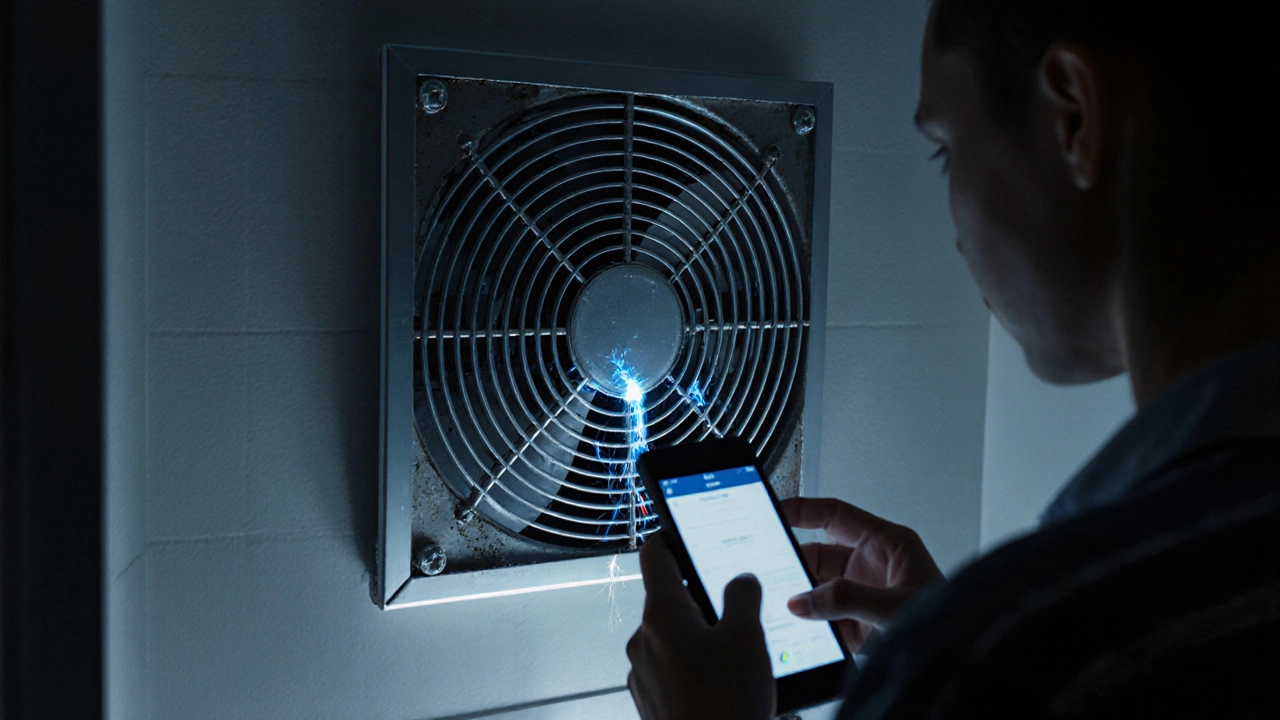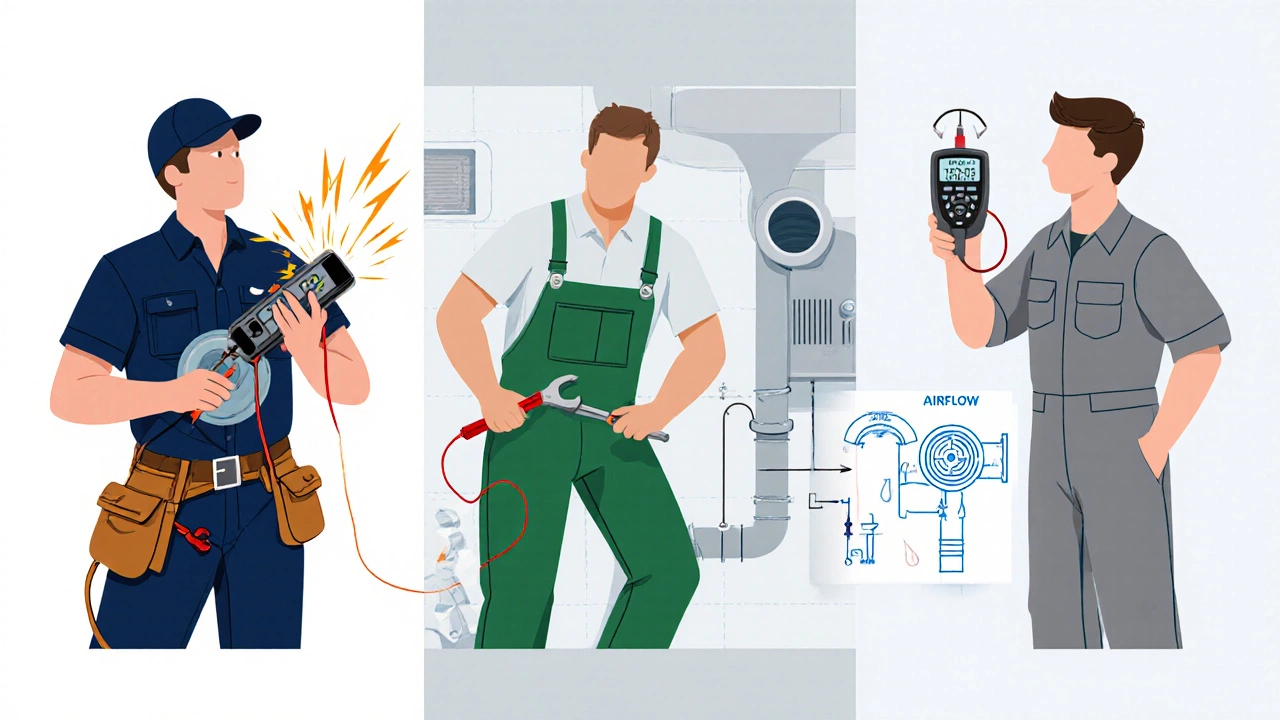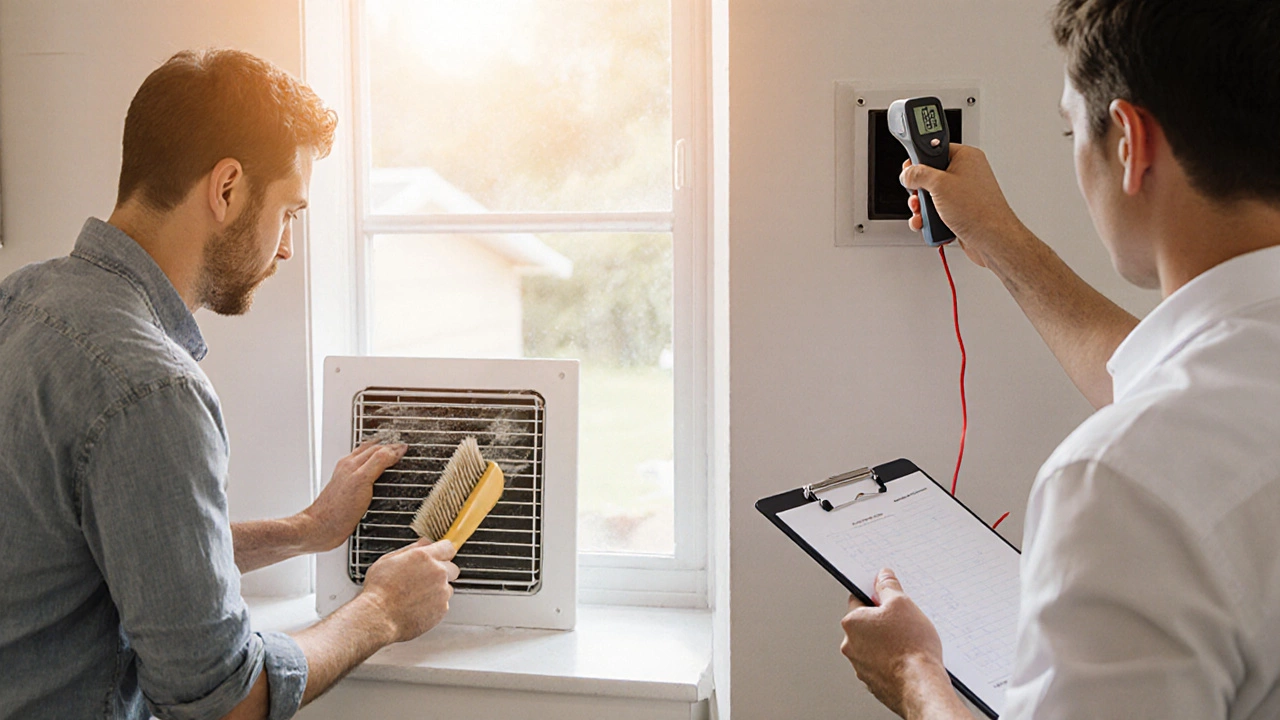
- 15 Oct 2025
- Gideon Thornton
- 0
When the bathroom or kitchen fan sputters, rattles, or stops altogether, the first question is who you should call. A faulty extractor fan can be an electrical problem, a duct issue, or even a simple blockage - and each cause points to a different trade. This guide cuts through the confusion, showing you exactly which professionals are equipped to handle each scenario, what credentials to look for, and how to avoid costly mistakes.
What is an extractor fan?
Extractor fan is a mechanical device installed in bathrooms, kitchens, or utility rooms to pull moist or polluted air out of a building and vent it to the outside. It typically consists of a motor, a fan blade, an intake grille, and a duct that leads to an external vent. In the UK, most residential units comply with BS EN 1507 standards for noise and performance.
Which trades can fix extractor fans?
Three main trades regularly service these units, each with a distinct skill set:
- Electrician a qualified professional who works with household wiring, circuit protection, and low‑voltage appliances. They handle motor failures, wiring faults, or any issue that involves the fan’s power supply.
- Plumber a tradesperson skilled in pipework, drainage, and wet‑area compliance. Plumbers step in when the ductwork is blocked, the vent cap is damaged, or condensation is causing rust inside the fan housing.
- HVAC technician a specialist in heating, ventilation, and air‑conditioning systems. They are the go‑to for complex ventilation networks, balancing airflow, or integrating smart controls.
Some larger projects may also involve a Building Services Engineer an engineer who designs and coordinates all mechanical and electrical services in a property, especially in new builds or major renovations.
Quick comparison of the trades
| Trade | Primary focus for fan issues | Key certification (UK) | Typical hourly rate (2025) | When to call |
|---|---|---|---|---|
| Electrician | Motor failure, wiring, switch & socket problems | PartP & City & Guilds Level3 | £65‑£85 | Fan doesn’t start, makes sparks, or trips the circuit breaker |
| Plumber | Duct blockage, vent cap damage, condensation‑related rust | NVQ Level2 in Plumbing & Heating | £55‑£75 | Air isn’t escaping, vent pipe is noisy or leaking water |
| HVAC technician | Airflow balancing, integrated smart controls, large‑scale ventilation | City & Guilds Level3 in HVAC | £70‑£95 | Complex system with multiple fans or need for performance testing |
| Building Services Engineer | System design, compliance checks for new builds | Chartered Engineer (CEng) or SENG | £90‑£130 (consultancy) | Whole‑home ventilation overhaul or new construction |

How to pick the right professional
- Check the licence. In England and Wales, electricians must be PartP registered and listed on the Electrotechnical Certification Scheme (ECS). Plumbers should appear on the Water Safe Register if they work on drainage.
- Verify insurance. Look for public liability cover of at least £2million - it protects you if something goes wrong during the repair.
- Ask for references or read recent reviews. A tradesperson who regularly works on ventilation will have specific feedback about fan performance.
- Get a written quote that breaks down labour, parts, and any extra work (e.g., duct cleaning). Transparent pricing helps you compare offers fairly.
- Confirm they follow the latest standards. For extractor fans, BS EN 1507 (noise) and Building Regulations PartF (ventilation) are the governing documents.
Typical costs and timeframes
For a basic repair - such as replacing a failed motor or fixing a loose connection - expect a total bill of £120‑£250, including parts and labour. More involved jobs, like re‑routing a vent pipe or installing a new high‑capacity fan, can run £300‑£600.
Most electricians and plumbers can complete a straightforward fix within 1‑2hours, while an HVAC technician may need 2‑4hours for airflow testing and calibration. If the job requires ordering a specific fan model, add a 3‑5day lead time for delivery.

DIY pitfalls - why you might want a professional
- Electrical safety. Even a low‑voltage fan is connected to your home’s mains supply. Working without proper isolation can cause electric shock or start a fire.
- Incorrect duct sizing leads to noise, reduced performance, and higher energy bills. Professionals use calibrated airflow meters to size ducts correctly.
- Improper sealing of the external vent can let rain in, causing rust and mold. A plumber or HVAC tech knows the right flashing and waterproofing methods.
- Void warranties. Many manufacturers (e.g., Vent-Axia) require a certified installer for the warranty to stay valid.
If you’re comfortable with basic screwdriver work and can check the fan’s power with a multimeter, you can clear dust or replace a simple grille yourself. Anything beyond that - especially when wiring or ductwork is involved - is best left to a qualified trade.
Maintenance tips to keep your fan running longer
- Clean the grille and fan blades every 6‑12months. A damp cloth and a soft brush are enough; avoid abrasive tools that could damage the housing.
- Run the fan for a few minutes after every shower or cooking session to dry out moisture and prevent mould buildup.
- Check the external vent cap yearly for blockages (leaves, nests) and clear them promptly.
- Listen for unusual noises. A whining motor often signals worn bearings - catching it early can avoid a full motor replacement.
- Schedule a professional inspection every 2‑3years, especially in older homes where duct corrosion is common.
Frequently Asked Questions
Do I need an electrician to replace the fan motor?
Yes. The motor is wired directly to the mains circuit, so only a PartP‑registered electrician should handle the replacement to ensure the work complies with building regulations and stays safely insulated.
Can a plumber fix a noisy fan?
A plumber can address noise caused by a blocked or improperly sealed duct, but if the noise originates from the motor itself, you’ll need an electrician. Often the two trades collaborate for a comprehensive fix.
What certification should I look for in an HVAC technician?
Look for City&Guilds Level3 in Heating, Ventilation and Air‑Conditioning (HVAC) and membership of the Refrigeration Engineers’ Association (REA). These credentials confirm they understand airflow dynamics and can safely work with electrical components.
How much does a full fan replacement cost?
A mid‑range residential fan (including motor, housing, and duct connections) typically costs £120‑£250 for parts. Adding labour from an electrician or plumber brings the total to £200‑£400, depending on the complexity of the installation.
Is it safe to DIY clean the fan blades?
Cleaning the blades and grille is generally safe if you turn off the circuit at the consumer unit first. Use a gentle brush and avoid getting water inside the motor housing. If you see any rust or the motor feels hot, stop and call a professional.




